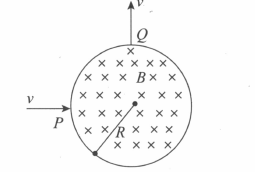Academic Experts Solutions for Chapter: Moving Charges and Magnetism, Exercise 2: Force Acting on a Charged Particle in Magnetic Field
Academic Experts Physics Solutions for Exercise - Academic Experts Solutions for Chapter: Moving Charges and Magnetism, Exercise 2: Force Acting on a Charged Particle in Magnetic Field
Attempt the practice questions on Chapter 1: Moving Charges and Magnetism, Exercise 2: Force Acting on a Charged Particle in Magnetic Field with hints and solutions to strengthen your understanding. Practice Book for MHT-CET Physics (Magnetism and Electromagnetic Induction) solutions are prepared by Experienced Embibe Experts.
Questions from Academic Experts Solutions for Chapter: Moving Charges and Magnetism, Exercise 2: Force Acting on a Charged Particle in Magnetic Field with Hints & Solutions
A particle of charge and mass enters normally (at point ) in a region of magnetic field with speed . It comes out normally from after time as shown in figure. The magnetic field is present only in the region of radius and is uniform as shown. Initial and final velocities are along radial direction and they are perpendicular to each other. For this to happen, which expression is correct?
A charged particle is released from rest in a region of uniform electric and magnetic fields, which are parallel to each other. The locus of the particle will be a
The charges are moving in a uniform transverse magnetic field. Then
A charged particle moves through a magnetic field perpendicular to its direction. Then
A proton, a deuteron and an -particle having the same kinetic energy are moving in circular trajectories in a constant magnetic field. If and denote, respectively, the radii of the trajectories of these particles, then
An electron is projected in vertically upward direction. If a uniform magnetic field acts from south to north, then it will be deflected
An -particle of energy moves along a circular path in a uniform magnetic field. The kinetic energy of a proton in the same magnetic field for a circular path of double radius is
A proton is projected with a speed of at an angle towards the . If a uniform magnetic field of is applied along the , the path of the proton is


